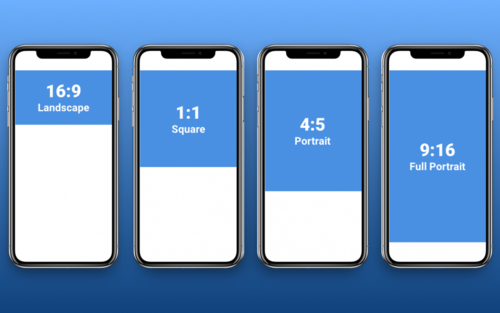by Farraz Khan | 9 Jan 2019
Aspect Ratio Summary
Vertical videos and square videos are more engaging on mobile devices. Now, you can easily select your orientation in Socialive to create vertical, square, or horizontal-format live video broadcasts.
Your video strategy is about content – what you say. But it’s as much, or more, about format – how you say it.
That’s why we’re excited to announce new orientations on Socialive, including vertical and square video for your live-video broadcasts.
It’s important to tailor your video format to the environment in which your audiences will consume it. When more people are consuming video content on their phones – over 70% of YouTube watch time happens on mobile devices, for instance – a mobile-first strategy can make your communications more effective.
That’s where vertical and square video come in.
Now, on Socialive, you can select the orientation for your live video with a couple clicks. Choose between a range of horizontal aspect ratios, vertical orientations, and square video. Then, start your broadcast and seamlessly stream the video to multiple channels, like Facebook, Twitter, YouTube, and more.
By crafting content for mobile consumption – and using popular mobile formats like vertical and square video – you can generate more watchable content and create variety in your video output.
Learn more about vertical video, square video, and aspect ratios on our Support page.
Why are vertical and square videos effective?
Vertical video refers to portrait orientation – where the frame is taller than it is wide – which is different from the traditional, horizontal aspect ratio of film and video – where the frame is wider than it is tall.
Vertical video allows you to fill the entire screen of a mobile device when a viewer holds the phone vertically (which people do 94% of the time, even when consuming horizontal content.) By comparison, a horizontal video will only fill around one-third of the frame.
That’s one of the reasons why vertical video is more compelling a format on mobile – an insight Snap shared as far back as 2015, when it reported that viewers watched vertical ads to completion 9x more often than horizontal ads.

Socialive customer Forward uses 4:5 portrait orientation on Facebook Live
The watchability of vertical and square video also has to do with habituation. With the popularity of apps like Snap and Instagram, users have grown more accustomed to mobile-specific formats like vertical and square video.
And, perhaps, individuals read into video formats, seeing mobile formats as a signal of authentic, accessible, social-style content, while interpreting traditional formats as less personal, immediate, and engaging. (This may be because individuals are now content creators themselves. In 2017, users were creating 3 billion Snaps – image and video – per day, and nearly all were vertical.)
As Instagram has eclipsed Snap, square videos will grow in popularity, too – another mobile-native format that connotes the same ease and authenticity of vertical videos, though without the intuitive advantage of full-screen vertical video.
Non-traditional aspect ratios – meaning, more vertical or squarish proportions – also perform better as ads. Facebook and Instagram, for example, recommend a 4:5 aspect ratio – a frame that is slightly taller than it is wide.
In 2019, mobile devices will account for 72% of all online video viewing – more than PCs, laptops, and smart TVs combined. Keep that in mind when creating video content, and make use of alternative orientations and aspect ratios to make your video more watchable.

